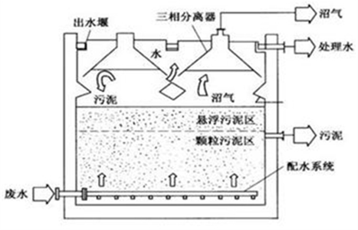he UASB anaerobic reactor is an anaerobic biological method for treating wastewater. At the bottom of the reactor, there is a high concentration and high activity sludge bed, where most of the organic pollutants in the wastewater are anaerobically fermented and degraded into methane and carbon dioxide. The agitation of bubbles creates a suspended layer of sludge above the sludge bed. The upper part of the reactor is equipped with a three-phase separator for separating digestion gas, digestion liquid, and sludge particles. Digestive gas is exported from the top of the reactor; The sludge particles automatically slide and settle to the sludge bed at the bottom of the reactor; Digestive fluid is discharged from the clarification area. UASB has a high load capacity and is suitable for the treatment of high concentration organic wastewater. A well functioning UASB has a high organic pollutant removal rate, does not require stirring, and can adapt to significant load shocks, temperature, and pH changes.
★ Process flow

★ Equipment advantages
·The biomass in the sludge bed is high, and the calculated concentration can reach 20-30 g/L.
·The volumetric load rate is high, and under medium temperature fermentation conditions, it can generally reach around 10kgCOD/(m ³. d), and even up to 15-40kgCOD/(m ³. d). The hydraulic retention time of wastewater in the reactor is relatively short, so the required tank capacity is greatly reduced.
·The equipment is simple and easy to operate, without the need for sedimentation tanks and sludge reflux devices, filling materials, or mechanical stirring devices in the reaction zone.
·The cost is relatively low, easy to manage, and there is no blockage problem.
★ Scope of application
